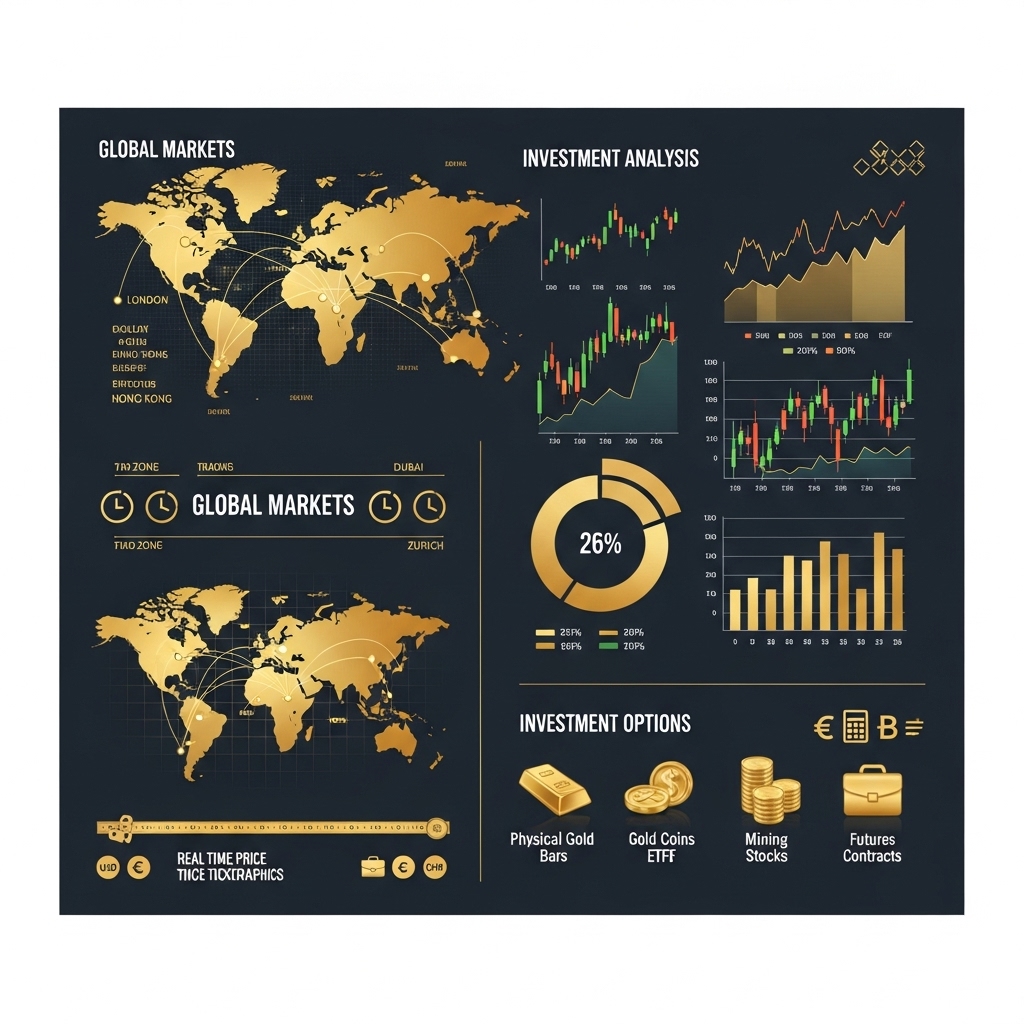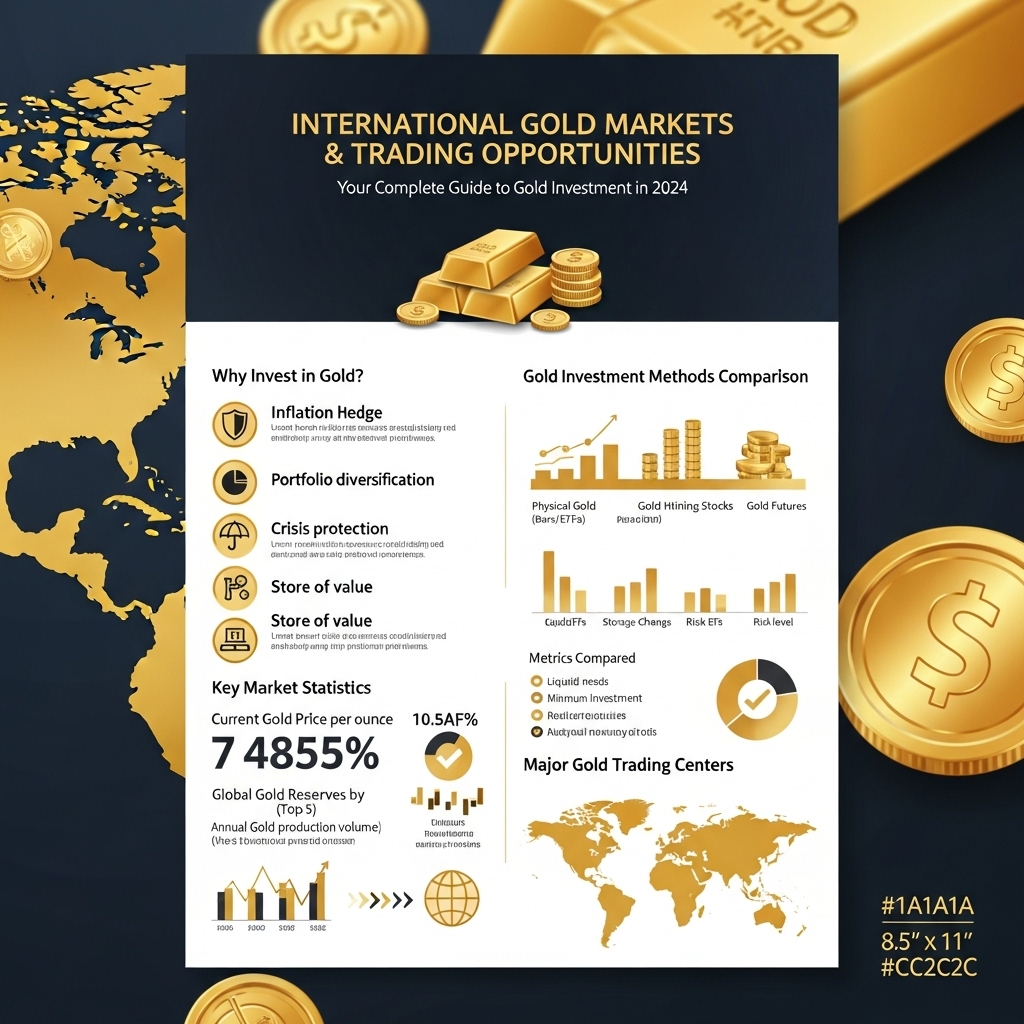International Gold Markets: Your Gateway to Global Precious Metals Opportunities
While central banks worldwide added over 1,000 tons of gold to their reserves in 2023—the highest level in over 50 years—savvy investors are discovering that domestic gold markets only tell half the story. From London’s century-old trading floors to Shanghai’s rapidly expanding gold exchange, international markets offer compelling opportunities that many investors are leaving untapped.
The global gold landscape presents a complex web of arbitrage possibilities, currency hedges, and diversification strategies that extend far beyond traditional bullion purchases. Asian markets trading at premiums to Western exchanges, emerging market central bank policies driving demand spikes, and geopolitical tensions creating regional price disparities—these are the dynamics shaping today’s international gold investment environment.
This comprehensive analysis will guide you through the major global gold trading centers, from London’s LBMA and New York’s COMEX to Asia’s growing influence through Shanghai and Hong Kong exchanges. We’ll explore practical strategies for capitalizing on international price differences, navigating currency considerations, and understanding how global economic policies impact regional gold markets. Whether you’re seeking portfolio diversification beyond domestic exposure or looking to capitalize on emerging market gold trends, understanding international markets has become essential for maximizing your precious metals investment potential in today’s interconnected world.
Gold Market Analysis and Key Insights
Current Market Dynamics and Price Trends
The international gold market has demonstrated remarkable resilience in 2024, with spot prices fluctuating between $1,950-$2,100 per ounce. Central bank purchases reached a decade-high of 800 tonnes in Q3 2024, primarily driven by emerging market economies diversifying their reserves. The London Bullion Market Association reports daily trading volumes averaging $180 billion, indicating robust liquidity and investor confidence.
Geopolitical tensions and persistent inflation concerns have reinforced gold’s safe-haven appeal. The Federal Reserve’s shifting monetary policy stance, with potential rate cuts anticipated in 2025, continues to influence precious metals sentiment positively.
Investment Benefits and Strategic Considerations
Gold offers compelling portfolio diversification benefits, historically maintaining negative correlation with equities during market stress periods. The metal provides effective inflation hedging, with purchasing power preservation over extended timeframes. Physical gold eliminates counterparty risk, while gold ETFs offer convenient exposure with lower storage costs.
However, investors must consider gold’s price volatility and lack of income generation. Storage and insurance costs for physical holdings can impact returns, while currency fluctuations affect international investors differently.
Trading Opportunities Across Global Markets
The 24-hour global gold trading cycle presents multiple opportunities across major exchanges. Asian markets, particularly Shanghai Gold Exchange, influence morning price discovery, while London’s LBMA dominates European trading hours. COMEX futures in New York provide extensive derivatives opportunities for sophisticated investors.
Digital gold platforms and blockchain-based gold tokens are emerging as innovative investment vehicles, offering fractional ownership and enhanced liquidity.
Expert Recommendations
Leading analysts recommend allocating 5-15% of investment portfolios to gold, depending on risk tolerance and economic outlook. Dollar-cost averaging into gold positions can mitigate timing risks, while maintaining long-term perspective remains crucial given gold’s cyclical nature.
Consider combining physical holdings with ETF exposure for optimal flexibility. Monitor Federal Reserve policy signals, inflation data, and global central bank activities as key market drivers for strategic positioning decisions.

Gold Investment Strategies and Options
International gold markets offer diverse investment opportunities for portfolio diversification and wealth preservation. Understanding various strategies and their risk profiles is essential for informed decision-making.
Investment Vehicles and Approaches
Physical Gold includes coins, bars, and jewelry, providing direct ownership but requiring secure storage and insurance. Gold ETFs offer convenient exposure without physical possession concerns, while gold mining stocks provide leveraged exposure to gold prices with additional operational risks.
Gold futures contracts enable sophisticated strategies including hedging and speculation, though they require substantial market knowledge. Digital gold platforms have emerged as modern alternatives, combining physical backing with digital convenience.
Risk Assessment and Portfolio Allocation
Financial advisors typically recommend 5-10% gold allocation for conservative portfolios, potentially increasing to 15-20% during economic uncertainty. Gold historically exhibits negative correlation with stocks during market stress, making it an effective diversifier.
Key risks include price volatility, currency fluctuations for international investments, and opportunity cost during strong equity markets. Storage and insurance costs for physical gold can erode returns over time.
Comparative Analysis
ETFs offer superior liquidity and lower transaction costs compared to physical gold. Mining stocks provide higher potential returns but carry operational and geopolitical risks. Futures require minimal capital but involve leverage risks and expiration dates.
Market Timing Considerations
Gold often performs well during inflationary periods, currency debasement, and geopolitical tensions. However, timing markets consistently proves challenging. Dollar-cost averaging through regular purchases can mitigate timing risks.
Seasonal patterns suggest stronger performance in certain months, though these trends aren’t guaranteed. Monitoring central bank policies, inflation expectations, and global economic indicators helps inform strategic decisions while maintaining long-term perspective on gold’s wealth preservation role.
Market Performance and Outlook
Historical Performance Data
Gold has demonstrated remarkable resilience over the past decade, rising from approximately $1,200 per ounce in 2014 to peaks exceeding $2,400 in 2024. The precious metal delivered exceptional returns during crisis periods, notably gaining 25% in 2020 amid pandemic uncertainty and reaching new highs during recent geopolitical tensions.
Current Market Conditions
Gold markets currently reflect heightened volatility driven by conflicting economic signals. Central bank purchases remain robust, with emerging economies accumulating reserves at unprecedented levels. ETF holdings show mixed patterns, while physical demand from Asia continues supporting price floors around $2,000 per ounce.
Economic Factors
Key price drivers include Federal Reserve monetary policy, inflation expectations, and dollar strength. Rising real interest rates traditionally pressure gold prices, while currency debasement concerns boost demand. Geopolitical risks, including ongoing conflicts and trade tensions, maintain elevated safe-haven premiums.
Future Outlook
Technical analysis suggests potential consolidation between $1,950-$2,100, with breakouts dependent on macroeconomic catalysts. Long-term fundamentals remain constructive, supported by:
– Continued central bank diversification away from dollar reserves
– Persistent inflation concerns despite recent moderation
– Structural shifts toward multipolar monetary systems
Trading opportunities exist in both directional plays and volatility strategies, particularly during Federal Reserve announcement periods and monthly employment data releases. Risk management remains crucial given increased correlation with equity markets during stress periods.
Frequently Asked Questions About Gold Investment
What are the major international gold markets?
The primary global gold trading centers include London (LBMA), New York (COMEX), Shanghai (SGE), and Tokyo (TOCOM). London serves as the world’s largest over-the-counter gold market, while COMEX handles the majority of futures trading. These markets operate across different time zones, enabling 24-hour gold trading.
How can I invest in gold internationally?
Investors can access gold through physical bullion, ETFs, futures contracts, mining stocks, and digital gold platforms. International options include London-allocated gold accounts, offshore storage facilities, and cross-border ETFs. Consider regulatory requirements and tax implications in your jurisdiction.
What factors drive gold prices globally?
Gold prices respond to inflation expectations, currency fluctuations (especially USD), geopolitical tensions, central bank policies, and economic uncertainty. Supply factors include mining production and central bank gold purchases or sales.
Are there tax implications for international gold investments?
Tax treatment varies significantly by country and investment method. Physical gold may incur capital gains tax, while some jurisdictions treat gold as a collectible with higher tax rates. Consult local tax professionals before investing.
How do I ensure secure international gold storage?
Use reputable allocated storage facilities in stable jurisdictions like Switzerland, Singapore, or Canada. Verify insurance coverage, segregated storage options, and regular auditing. Choose facilities offering easy liquidity and transparent fee structures.

Final Thoughts on Gold Investment
The international gold markets offer diverse opportunities for savvy investors willing to navigate global complexities. Key takeaways include understanding how geopolitical events, currency fluctuations, and regional demand patterns create price disparities across markets. Smart investors should diversify across physical gold, ETFs, and mining stocks while staying informed about Asian market trends and central bank policies.
Investment Recommendation: Allocate 5-15% of your portfolio to gold as a hedge against inflation and economic uncertainty. Focus on liquid, low-cost options like established gold ETFs for beginners, while experienced investors can explore international mining equities and futures contracts.
Ready to capitalize on global gold opportunities? Start by researching reputable precious metals dealers and low-fee gold ETFs. Subscribe to our newsletter for weekly market analysis and follow our recommended gold tracking tools to stay ahead of international price movements.